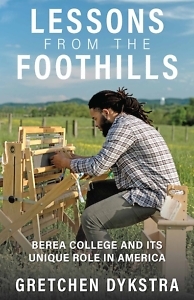Feeling Welcome and at Home
Reflections on Berea College
In Lessons from the Foothills, Gretchen Dykstra lays out the Berea College dream. The original mission of the school, founded in the Appalachian foothills of Kentucky in the 19th century, was to educate disadvantaged students. This mission was inclusive from the beginning, and Berea was the first integrated, coeducational college in the South — a concept so controversial that Berea was targeted in 1904 by Kentucky’s Day Law (named for state representative Carl Day), which made interracial education illegal. This is a story every Berean knows. It’s in the brochures, on the website, and in the curriculum.

Each chapter in Lessons from the Foothills is an exploration of Berea’s eight “Great Commitments”: to Christian values, educational opportunities for students of all races, gender equality, serving Appalachia, supportive and sustainable living, the dignity of labor, the kinship of all people, and the liberal arts.
Dykstra digs into Berea’s past and present, from its founding by John G. Fee, a Kentucky-born preacher with a dream of an integrated school that served Appalachians, to the modern college dealing with the challenges of COVID, the struggle to attract white male Appalachian students, and the ever-present push to help impoverished communities in the region.
Berea is a place that makes space for many beliefs. I remember that best. From August 2009 to September 2013, I attended Berea. Walking on campus the first day, I felt so welcome and at home. Even, maybe especially, among the many debates and opposing views. In one sociology class my sophomore year, I remember a white male student ranting about affirmative action and the professor telling him that he was one of the biggest beneficiaries of affirmative action at Berea because white men performed at a lower level academically than white women. I don’t know if what the professor said is true, but I’ll never forget it. That exchange — the debate, the coexisting of opposing sides under one shared umbrella devoted to aiding the less privileged — is Berea.
The school was born out of great struggle and turmoil. Fee, the son of a farmer who relied on enslaved laborers, opened a one-room schoolhouse in 1855 on land given by abolitionist Cassius Marcellus Clay, himself the son of a wealthy slaveholder. Fee and his family were driven out of town in 1859 but returned to reopen the school in 1864 with fellow teacher John Rogers. Dykstra describes the complex challenges they faced:
Nearby communities vehemently opposed the school. The students had to ignore the rigid societal expectations of them, dictated by both race and gender: white students had to overcome their racial prejudices, Black students had to endure that prejudice, and white women were expected to interact with Black men. But soon both Black and white, men and women, with dramatically different educational levels, studied, worked, and ate together. John Rogers wrote, “We had cheerful courage amid poverty and opposition.”
During the Day Law period, Black students were transferred to a school in Louisville, and even before that, the school’s president, William Frost, had begun reducing the percentage of Black students. Dykstra writes, “On the eve of the Day law, there were 926 students at Berea, and 805 were white.” It would take 46 years for the law to be rescinded and for Berea to begin reintegrating.
 Today, the desire to educate students with low means and great potential is still at the heart of Berea’s purpose. Poverty does not set a student apart there. Everyone falls below the poverty line. In fact, this is what I loved the most about being a Berea student. I was never alone in my circumstances. I needed only look to my side and know someone else had a family who was also barely surviving; someone else had a family struggling with depression, anxiety, and the desire to give up. There were many happier things we shared, but as Dykstra points out, it is sometimes the heaviest things that connect the students. Knowing I was never really alone is part of the reason I survived.
Today, the desire to educate students with low means and great potential is still at the heart of Berea’s purpose. Poverty does not set a student apart there. Everyone falls below the poverty line. In fact, this is what I loved the most about being a Berea student. I was never alone in my circumstances. I needed only look to my side and know someone else had a family who was also barely surviving; someone else had a family struggling with depression, anxiety, and the desire to give up. There were many happier things we shared, but as Dykstra points out, it is sometimes the heaviest things that connect the students. Knowing I was never really alone is part of the reason I survived.
Students coming into Berea face many difficulties. Beyond poverty, they face social and personal pressures. Bereans get a free education; tuition is fully paid for every student. In return, each student works to contribute to the community. I knew many students who sent all of the little they made to their families to support them. Today, student work is valued at over $34 an hour. The college takes most of that to support students’ education, so the starting take-home pay is $6.09 per hour. When I was in school that number was around $3.50.
With the little they had, the students I knew sacrificed. They weren’t buying essentials; they were sending money home for food. The only time I disagree with Dykstra’s depiction of Berea is when she unintentionally underestimates the students’ struggles. The amount students are expected to contribute to their education would be nominal in most peoples’ eyes. Yet every dime a student was expected to pay from their earnings was a dime most of my friends didn’t have. It was a dime taken away from money they could have sent home. Berea does so much, and we all have to contribute something. But even that safety net has a few holes. As much as students are given, there is still struggle.
Yet, on a campus with so much diversity and history, the fact that everyone comes from the similar kinds of poverty is wildly freeing. I’ve never been in another place where what I didn’t have was the reason we were the same. I’ve haven’t found anything like it, and I wonder if I will again. Berea is unique, a bright light, and Dykstra does a wonderful job of exploring this extraordinary institution.

Jessica Ciccarelli is a nonfiction writer who graduated from Berea College and holds an M.F.A. from New York University. Her work has appeared in Harvard Review. She lives in Kentucky, where she is working on a memoir set in Louisiana about loss and returning home.


